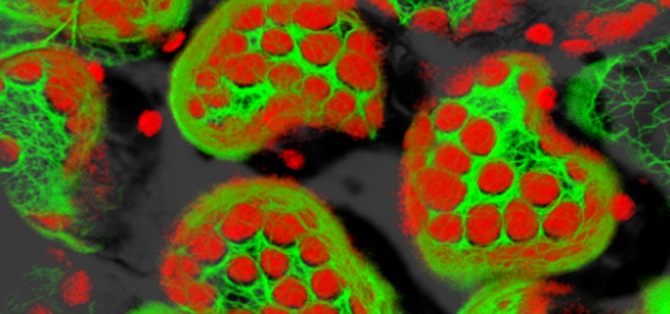Prokaryotes can exchange genomes.

Mass analysis of almost every sequence of the bacterial genome today proposes to revise and create a new form of the Tree of Life.
One of its main branches, apparently, the union of the other two. The energy centers of plant and animal cells became descendants of this line.
In other words, the results of this distant alliance between microorganisms "allowed us to walk the earth," said James Lake , cell analysis author and microbiologist at the University of California, Los Angeles. "Their responsibility for oxygen in the atmosphere, and the appearance of the organelles that plants produce, and allowed us to breathe air."
The details of early cell evolution remain a mystery, since it can only be investigated through a few fossils that have remained intact for the billions of years that have passed since the self-replication of the primary chemical precellular forms. But in general, scientists know that the early organisms were single-celled, nuclear-free creatures called prokaryotes.
They are divided into five groups: bacteria, archaea, clostridia, actinobacteria and the so-called gram-negative bacteria. For most people, prokaryotes are just a bunch of microscopic creatures, but for microbiologists they look like a rich, animal kingdom.
Scientists believe that the first eukaryotes - unicellular creatures with nuclei and a complex internal structure, from which the whole plant and animal kingdom emerged - evolved from prokaryotes, i.e. some prokaryotes transformed into these new and complex organisms.
The best known examples of this are the uptake of mitochondria and chloroplasts, structures that produce energy in animal and plant cells. Both belong to the gram-negative class, as well as the cyanobacteria, which over several billion years, probably transformed the Earth's atmosphere from a toxic mass into an oxygen-rich one through photosynthesis.
')
According to Lake, the origin of this gram-negative group is not unique. Instead, it appears to have occurred as a result of the fusion of actinobacteria and clostridium. This means the restructuring of all ideas about the history of life development, comparable in depth to the fact that if suddenly it turned out that mammals were descended from the merger of insects and amphibians.
“If these results are confirmed and spread, it will certainly have a serious impact on our perceptions of prokaryotes and the evolution of eukaryotes,” said Michael Gray , a microbiologist at University of Deluis, known for the discovery of bacterial origin of mitochondria. Gray, did not participate in these studies.
Lake's hypothesis is based on a structural analysis of more than 3,000 species of bacteria conducted over the genome sequences. For three years, he tested the interaction algorithms in between different genes, and only then offered various explanations of their taxonomies.

Most importantly, he suggested that the genes do not have to move in the same direction, as happens in the animal kingdom. In bacteria, genes can move back and forth, unhindered, so some scientists believe that the concept of species is not applicable to them .
“People have always assumed that evolution works in a tree. What we saw
allows you to analyze things in such a way that you can drop the tree view and see what happens, ”says Lake.
Of the more than a million possible taxonomic relationships, there is only one that best fits the data and characterizes gram-negative prokaryotes, as a descendant of some ancient compounds of actinobacteria and clostridium groups.
This hypothesis cannot be tested on fossil, but it could explain why Gram-negative prokaryotes and Clostridium are both capable of photosynthesis, a phenomenon called Gray, as "universal bewilderment."
“We are aware of gram-negative bacteria, already for three scientific generations. We have been based on them for a hundred years in research, and we still don’t know how they came about and what made them so different, ”said Lake. "Without them, we would not have eukaryotes, which we are seeing now."
According to Lake, this association most likely has the form of endosymbiosis , in which one of the prokaryotes literally swallowed the other, and both grew together. Gray interprets this “problem” interpretation: It would require one genome to cross the cell membrane and join another. “I don’t know such a mechanism that would allow to do this,” said Gray.
But Gray does not deny the possibility of an endosymbiotic union, suggesting that the process by which prokaryotes can exchange entire genomes is still unknown. This opportunity is “Not so widely seen within an evolutionary community,” he said.
Ten years ago, such an investigation into such matters would not have been possible at all, says Lake. “We must have bases in mathematics and genetics to consider all these sequences,” he said.
Source: https://habr.com/ru/post/67571/
All Articles